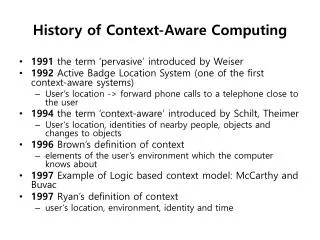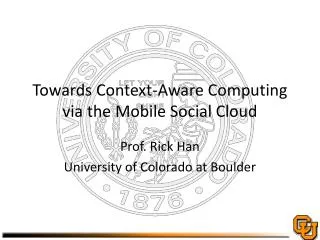
Context-Aware Mobile Computing. Amanda Draheim. Overview. Definition Examples History Issues Solutions Future. Definition. What is context?

elwyn + Follow
Download PresentationAn Image/Link below is provided (as is) to download presentation Download Policy: Content on the Website is provided to you AS IS for your information and personal use and may not be sold / licensed / shared on other websites without getting consent from its author. Content is provided to you AS IS for your information and personal use only. Download presentation by click this link. While downloading, if for some reason you are not able to download a presentation, the publisher may have deleted the file from their server. During download, if you can't get a presentation, the file might be deleted by the publisher.

Context-aware Computing: Basic Concepts. 金仲達教授 清華大學資訊系統與應用研究所 九十三學年度第一學期. Outline. Motivation Context and Context-aware Computing Context-aware Applications Developing Context-aware Applications Issues and Challenges Special Topics Summary. Sources.
1.71k views • 125 slides

Context-Aware Computing. CSE494/598 Mobile Health and Social Networking. Context awareness: the essence of adaptability. Context awareness Resource awareness Adapt to available resources (connectivity, nearby devices Situation awareness
855 views • 42 slides

Context Aware Computing Survey Notes. Changqing Zhou To discuss with Prof. Shekhar on September 26, 2002. Goal. Survey a broad variety of areas Get familiar with the terminologies Identify potential interesting points Whats next. Summary. UniComp 2002 Latest technology
530 views • 32 slides

Context-Aware Computing: Integration with Rover. Christian B. Almazan almazan@cs.umd.edu CMSC 818Z – Spring 2007 13 February 2007. What is Context?. An Attribute? Location of an Event Time of a Message Temperature of the Room Person of Interest Provided as Part of Something Else?
490 views • 33 slides

The Context Fabric: An Infrastructure for Context-Aware Computing. Jason I. Hong Group for User Interface Research, Computer Science Division University of California, Berkeley Seungseok Kang. Introduction. Context The circumstance in which an event occurs
281 views • 8 slides

Context Aware Mobile Commerce. For CSE 535 Mobile Computing Phase III Colin Juillard , Duo Li, Joseph Caglio , Sayan Cole. Road Map. Goal/Motivation General approach Accelerometer context collection and analysis. Accessibility function implementation. Goal & Motivation.
373 views • 26 slides

A Survey of Context-Aware Mobile Computing Research. Guanling Chen and David Kotz Dartmouth Computer Science Technical Report, 2000. Outline. Introduction Definition of Context Context-Aware Computing Context-Aware Application Sensing Context Modeling Context Information
532 views • 23 slides

I5180 Context-Aware Computing. In tro duction. Overview. Living in a Digital World Modelling the Key Ubiquitous Computing Properties C ourse Outline. Layers of a Computing System. 4. Evolution of HCI “ interfaces ”. 50s - Interface at the hardware level for engineers - switch panels
700 views • 50 slides

Ebiquity Lab: Context - Aware Mobile Computing. Tim Finin University of Maryland, Baltimore County Joint work with Anupam Joshi, Laura Zavala, Radhika Dharurkar , Pramod Jagtap , Dibyajyoti Ghosh and Amey Sane. http:// ebiq.org /r/342. Ebiquity research group. social.
454 views • 30 slides

Intro to Context-Aware Computing. Jason I. Hong. Context-Aware Computing. Shift from explicit to implicit interaction Use this implicit input to adapt systems to situation. Where you are Who you are with What resources Lighting and noise level Network connectivity Social situation
370 views • 16 slides

Policy-Based Context-Aware Applications for Mobile Computing. José Viterbo Filho viterbo@lac.inf.puc-rio.br. Laboratory for Advanced Collaboration. Norms and policies.
285 views • 16 slides

Context-Aware Computing Overview and Case Studies. Marko Jurmu MediaTeam Oulu Group University of Oulu Finland March 13 th , 2007. Outline:. Fact Sheet: Finland Motivation Definitions of Context Effects of Context-Awareness Example Application Domains CASE 1: Connectivity Management
369 views • 22 slides

A survey of Context-Aware Mobile Computing Research. Guanling Chen and David Kotz , Department of Computer Science Dartmouth College. Introduction. Two technologies allow users to move about with computing power and network resources at hand. portable computer, wireless communications
221 views • 9 slides

History of Context-Aware Computing. 1991 the term ‘pervasive’ introduced by Weiser 1992 Active Badge Location System (one of the first context-aware systems) User’s location -> forward phone calls to a telephone close to the user
243 views • 9 slides

What is Context-Aware Computing?. Some definitions: Context: The physical and social situation in which the person/ device is a part of. Example Contexts: time of day, location, other people/devices, temperature, sound, light/vision, motion, network/internet, etc.
697 views • 11 slides

Towards Context-Aware Computing via the Mobile Social Cloud. Prof. Rick Han University of Colorado at Boulder. Context-Aware Mobile Social Networks. Social Networks. Who?. Where?. My Preferences My Friends. Context-Aware “System”. Context-Aware Mobile Applications.
183 views • 7 slides

Situation Aware Mobile Computing (SAMC). CPSC 608 Project Spring 2002 Project Members: Brent Dinkle Hemant Mahawar Marco Morales Sreekanth R. Sambavaram. General Problem Statement.
245 views • 15 slides

Mobile , Collaborative and Context-Aware Systems. Laura Zavala, Radhika Dharurkar , Pramod Jagtap , Tim Finin, Anupam Joshi and Amey Sane University of Maryland, Baltimore County AAAI Workshop on Activity Context Representation 07 August 2011. http://ebiquity.umbc.edu/p/539/. Agenda.
431 views • 30 slides

A Survey of Context-Aware Mobile Computing Research. Guanling Chen and David Kot Department of Computer Science Dartmouth College Dartmouth Computer Science Technical Report TR2000-381. Outline. About context Context-aware computing/application Context sensing Context modeling Issues.
131 views • 12 slides

What is Context-Aware Computing?. Some definitions: Context: The physical and social situation in which the person/ device is a part of. Example Contexts: time of day, location, other people/devices, temperature, sound, light/vision, motion, network/internet, etc.
155 views • 11 slides

Context and Context-Aware Computing. Omar Khan CS260, Fall 2006. Background. Ubiquitous computing in early 90s: computing everywhere and “ invisible ” Implication Create applications that work seamlessly in human environments Understanding of context. Olivetti Active Badges.
470 views • 40 slides